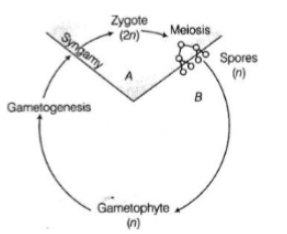Heterosporous pteridophytes include both:
1. Lycopodium and Equisetum
2. Selaginella and Salvinia
3. Psilotum and Phylloglossum
4. Selaginella and Equisetum
Sorry!! currently, the explanation for the question is not provided. If you need further help, please email at support@neetprep.com with subject: Explanation Missing for Question Id: 154686
Sorry!! currently, the explanation for the question is not provided. If you need further help, please email at support@neetprep.com with subject: Explanation Missing for Question Id: 154686
The life cycle is not haplo-diplontic in:
(1) Bryophytes
(2) Pteridophytes
(3) Polysiphonia
(4) Fucus
The endomembrane system of a eukaryotic cell includes all except:
1. Vacuoles
2. Lysosomes
3. Peroxisomes
4. Golgi complex
Asexaul reproduction by pear shaped biflagellate zoospores is seen in most:
(1) Green algae
(2) Brown algae
(3) Red algae
(4) Both (2) and (3)
All the following pteriodophytes belong to the Class Pteropsida except:
(1) Dryopteris
(2) Pteris
(3) Selaginella
(4) Adiantum
Sexual reproduction by non-flagellated but similar in size gametes is seen in:
1. Chlamydomanas
2. Volvox
3. Spirogyra
4. Fuccus
In mosses, the sex organs are seen in:
1. Protonema stage
2. Leafy stage
3. Capsule of the sporophyte
4. Seta of the sporophyte
The features seen in the gymnosperm Cycas include:
I. Coralloid roots
II. Unbranched stems
III. Pinnate persistent leaves
IV. Male cones and megasporophyllys borne on same plant
1. I and II only
2. I and IV only
3. I, II and III only
4. I, II, III, and IV
Both bryophytes and pteridophytes:
(1) are vascular cryptogams
(2) have a dominant sporophyte
(3) reproduce only sexually
(4) are haplo-diplontic
The life cycle pattern shown in the given diagram is not see in:

1. Chlamydomanas
2. Spirogyra
3. Volvox
4. Ectocarpus






